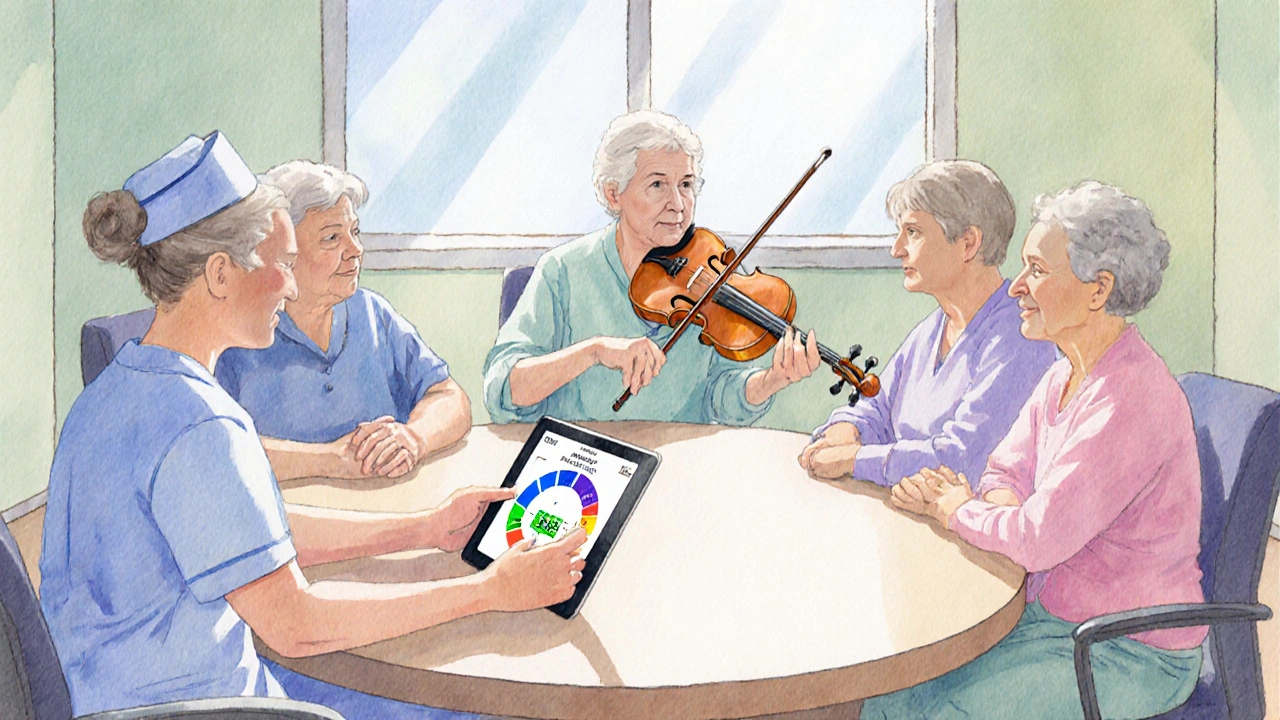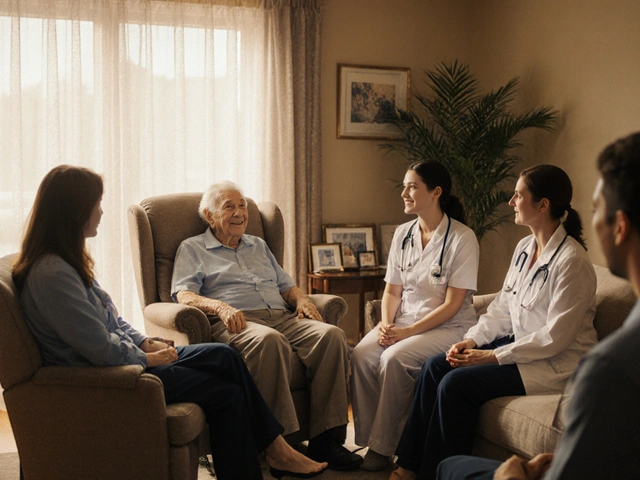Palliative Care for Alzheimer's Dementia: Quick Reference Guide
Key Benefits of Palliative Care
- Symptom Relief
- Advance Care Planning
- Caregiver Support
- Holistic Focus
Core Components
- Advance Care Planning
- Symptom Management
- Quality of Life
- Interdisciplinary Team
Step-by-Step Integration Process
- Early Identification: Flag at diagnosis using the Surprise Question
- Comprehensive Assessment: Evaluate medical, functional, behavioral, and psychosocial factors
- Goal-Setting Conversation: Discuss priorities with patient and family
- Create a Care Plan: Document goals and interventions
- Implement Symptom Controls: Start with non-pharmacologic approaches
- Ongoing Review: Reassess every 3-6 months or after changes
Common Challenges & Solutions
Misconceptions
Many believe palliative care means giving up. Clarify that it complements disease-modifying treatments.
Limited Access
Rural areas can use tele-palliative services and community nurse referrals.
Medication Overload
Regular medication reviews with pharmacists reduce risks.
Emotional Burden
Provide counseling, support groups, and respite options for caregivers.
Evidence-Based Outcomes
- 30% reduction in emergency department visits with integrated palliative care
- 45% lower odds of aggressive interventions with early advance care planning
- 4.2-point improvement in quality-of-life scores with systematic symptom management
Essential Tools for Practice
| Tool | Purpose | Typical Use |
|---|---|---|
| PAINAD Scale | Assess pain in non-communicative patients | Weekly nursing visits |
| CMAI | Quantify agitation frequency | Baseline and after medication changes |
| ADAPTES | Structured advance care planning | At diagnosis or capacity decline |
| Family Caregiver Stress Index | Screen caregiver burden | Quarterly check-in |
| Tele-Palliative Platform | Remote specialist input | When local expertise unavailable |
Emerging Trends in Palliative Care
- AI symptom predictors based on activity patterns
- Virtual reality reminiscence therapy
- Integrated EHR flags for automatic palliative referrals
Quick Checklist for Care Teams
- Identify Alzheimer’s-type dementia early and tag for palliative assessment
- Conduct full symptom and psychosocial evaluation within first month
- Hold goal-setting conversation with patient and family
- Document advance directives using ADAPTES or similar tools
- Implement non-pharmacologic strategies before medication
- Schedule interdisciplinary team reviews every 3–6 months
- Provide caregiver education, respite, and counseling resources
- Use the tool table above to select appropriate assessment tools
When dementia advances, especially the Alzheimer's type, families and clinicians often feel stuck between treating medical issues and preserving the person’s dignity. palliative care in Alzheimer's bridges that gap by focusing on comfort, goals, and quality of life rather than aggressive interventions alone.
What is Palliative Care?
Palliative Care is a multidisciplinary approach that aims to relieve suffering and improve quality of life for people with serious illnesses. It addresses physical, emotional, social, and spiritual needs, and it works alongside curative or disease‑modifying treatments.
Understanding Alzheimer’s‑type Dementia
Alzheimer’s disease is the most common cause of progressive dementia, characterized by memory loss, language difficulties, and impaired reasoning. When the disease progresses to moderate or severe stages, it is often referred to as Alzheimer’s‑type dementia, a condition that profoundly impacts daily living and caregiving.
Why Palliative Care Matters for Dementia
Traditional dementia care can be fragmented, focusing on medication or safety measures without a clear plan for comfort. Palliative care brings four key benefits:
- Symptom Relief: Treats pain, agitation, breathlessness, and sleep disturbances effectively.
- Advance Care Planning: Helps families record wishes before decision‑making capacity declines.
- Support for Caregivers: Provides emotional counseling, respite resources, and education.
- Holistic Focus: Considers spiritual, cultural, and social values alongside medical needs.

Core Components of a Palliative Approach
Advance Care Planning is the process of discussing and documenting a person’s preferences for future medical care, including goals, treatments, and end‑of‑life wishes. It should start early, ideally at diagnosis, and be revisited as the disease evolves.
Symptom Management involves systematic assessment and treatment of pain, agitation, falls risk, nutrition, and sleep problems. Using validated tools such as the PAINAD scale for pain or the CMAI for agitation ensures consistency.
Quality of Life is a subjective measure that includes physical comfort, emotional wellbeing, social connection, and sense of purpose. In dementia care, we often look at preserved moments of joy, meaningful activities, and the person’s ability to engage with loved ones.
Interdisciplinary Team is a group of professionals-physicians, nurses, social workers, spiritual care providers, and therapists-working together to coordinate care plans. Regular team meetings keep everyone aligned on goals and reduce duplication of effort.
Step‑by‑Step Guide to Integrating Palliative Care
- Step 1 - Early Identification: At diagnosis, flag the patient for a palliative assessment. Use the “Surprise Question” (Would you be surprised if this patient died within the next year?) to trigger referrals.
- Step 2 - Comprehensive Assessment: Conduct a baseline evaluation covering medical history, functional status, behavioral symptoms, psychosocial context, and cultural values.
- Step 3 - Goal‑Setting Conversation: Meet with the person (if possible) and family to clarify what matters most-remaining independent as long as possible, avoiding hospitalizations, or focusing on comfort.
- Step 4 - Create a Care Plan: Document agreed‑upon goals, preferred locations of care, and specific interventions (e.g., using low‑dose antipsychotics only for severe agitation).
- Step 5 - Implement Symptom Controls: Apply non‑pharmacologic strategies first (music therapy, environmental modifications). Add medications judiciously, monitoring side‑effects closely.
- Step 6 - Ongoing Review: Re‑evaluate every three to six months or after major changes (hospital discharge, new symptoms). Adjust goals as needed.
Common Challenges and How to Overcome Them
Caregiver is any family member, friend, or professional who provides unpaid or paid assistance with daily activities and medical tasks. Caregivers often feel guilt, exhaustion, or confusion about how much to intervene.
Challenges include:
- Misunderstanding Palliative Care: Many think it means “giving up.” Clear education that palliative care can coexist with disease‑modifying treatments is essential.
- Limited Access: Rural areas may lack specialist teams. Tele‑palliative services and community nurse referrals help bridge gaps.
- Medication Overload: Polypharmacy is common in dementia. Regular medication reviews, guided by a pharmacist, reduce risk.
- Emotional Burden: Provide counseling, support groups, and respite options to prevent burnout.
Evidence Supporting Palliative Care in Alzheimer’s Dementia
Recent studies underline the impact:
- A 2023 randomized trial in the UK showed a 30% reduction in emergency department visits for patients receiving integrated palliative care compared with standard memory clinic follow‑up.
- Meta‑analysis of 12 international cohorts (2021‑2024) found that early advance care planning lowered the odds of aggressive interventions (ventilation, feeding tubes) by 45%.
- Quality‑of‑life scores measured by the QoL‑AD instrument improved by an average of 4.2 points when systematic symptom management was applied.

Practical Tools for Clinicians and Families
| Tool | Purpose | Typical Use |
|---|---|---|
| PAINAD Scale | Assess pain in non‑communicative patients | During weekly nursing visits |
| CMAI (Cohen‑Mansfield Agitation Inventory) | Quantify agitation frequency | Baseline and after medication changes |
| ADAPTES (Advance Directive for People with Dementia) | Structured advance care planning | At diagnosis or when capacity declines |
| Family Caregiver Stress Index | Screen caregiver burden | Quarterly check‑in |
| Tele‑Palliative Consultation Platform | Remote specialist input | When local expertise unavailable |
Looking Ahead: Emerging Trends
By 2026, several innovations promise to enhance palliative care for dementia:
- Artificial‑Intelligence Symptom Predictors: Machine‑learning models that forecast agitation episodes based on activity patterns.
- Virtual Reality reminiscence therapy: Low‑cost headsets that trigger positive memories, reducing anxiety.
- Integrated Electronic Health Records (EHR) flags: Automatic alerts when a patient meets criteria for palliative referral.
Take‑Home Checklist for Care Teams
- Identify Alzheimer’s‑type dementia early and tag for palliative assessment.
- Conduct a full symptom and psychosocial evaluation within the first month.
- Hold a goal‑setting conversation with the patient (if possible) and family.
- Document advance directives using ADAPTES or similar tools.
- Implement non‑pharmacologic strategies before medication.
- Schedule interdisciplinary team reviews every 3-6months.
- Provide caregiver education, respite, and counseling resources.
- Use the table above to select appropriate assessment tools.
Frequently Asked Questions
Is palliative care only for end‑of‑life patients?
No. In dementia, palliative care starts at diagnosis and runs alongside disease‑modifying treatments. Its goal is to improve comfort and quality of life throughout the disease trajectory.
When should advance care planning be introduced?
Ideally soon after diagnosis, while the person can still express preferences. Revisit the plan whenever health status changes or new care decisions arise.
What non‑pharmacologic methods help with agitation?
Music therapy, personalized reminiscence, safe lighting, structured routines, and scent cues can calm many patients. These should be tried before antipsychotics.
How can rural families access palliative expertise?
Tele‑palliative services, regional hospice outreach teams, and training primary‑care clinicians in basic palliative skills are effective ways to bring expertise to remote settings.
What are the signs that medication review is needed?
New falls, increased confusion, worsening sleep, or any new side‑effects suggest it’s time for a pharmacist‑led medication reconciliation.


Joshua Logronio
Hey folks, I’ve read that big pharma doesn’t want you to hear about palliative care because it cuts into their meds profit, so they spread the myth that it’s only for dying patients – alzo it’s weird how the system pushes aggressive treatments even when the quality of life is crumbling. Friendly reminder: keep an eye out for hidden agendas and ask your doc why they aren’t mentioning holistic options earlier. Stay curious and stay safe.
Nicholas Blackburn
Listen, your paranoid ramblings are a disgrace to anyone who actually reads the literature, the data is clear and you’re misrepresenting the facts. Get your grammar right and stop spreading nonsense.
Dave Barnes
One could argue that the essence of dignity in dementia is a philosophical construct, yet when we talk about palliative care we are really confronting the question of what it means to be human in the face of inevitable loss. The interplay between autonomy and compassion creates a rich tapestry that challenges our conventional ethics, and the gentle guidance of interdisciplinary teams helps weave that tapestry into something meaningful.
Kai Röder
Thank you for sharing this comprehensive guide. It’s important for care teams to remember that inclusive communication respects the person’s cultural background and personal values, and that regular interdisciplinary meetings can prevent duplication of effort. Encourage families to voice their hopes and fears, and provide resources that empower them rather than overwhelm them.
Brandi Thompson
The integration of palliative care into Alzheimer’s management is not merely an optional add‑on but a fundamental restructuring of how we approach chronic neurodegeneration. When clinicians understand that symptom relief, advance care planning, and caregiver support are interdependent pillars the entire trajectory of the disease is reframed from a relentless decline to a series of manageable phases. Evidence shows that emergency department visits drop dramatically when a coordinated palliative team is involved and this reduction translates into lower healthcare costs and less stress for families. Moreover the quality‑of‑life scores improve significantly, reflecting better sleep, reduced agitation, and more meaningful interactions. The PAINAD and CMAI tools, when used consistently, provide objective data that guide medication adjustments without over‑reliance on sedatives. Caregiver burden indexes reveal that regular counseling and respite services cut burnout rates in half, preserving the essential support system for the patient. Tele‑palliative platforms extend specialist expertise to rural settings, breaking the geographic barrier that has long limited access to comprehensive care. Advanced care planning documents, such as ADAPTES, ensure that patient wishes are honored even when decision‑making capacity wanes. Interdisciplinary team reviews every three to six months create a feedback loop that adapts the care plan to evolving needs. The inclusion of virtual reality reminiscence therapy offers a novel, low‑risk stimulus that can soothe anxiety and trigger positive memories. Artificial‑intelligence symptom predictors are on the horizon, promising to anticipate agitation before it escalates, allowing pre‑emptive non‑pharmacologic interventions. By embedding palliative principles from diagnosis onward we shift the focus from merely extending life to enriching the lived experience, which is the ultimate goal of medicine. The data is compelling, the tools are available, and the moral imperative is clear: we must adopt this approach universally.
Chip Hutchison
I appreciate the thoroughness of this guide. It resonates with many families I’ve spoken to who feel isolated navigating dementia. Remember to validate the caregiver’s emotions and encourage them to take breaks; a rested caregiver provides better support. If you’re unsure about tools like the PAINAD, reach out to a local hospice for training.
Emily Moody
Patriotic physicians must recognize that our nation’s greatness hinges on how we care for the most vulnerable, and palliative care is a battlefield where we fight against needless suffering. The jargon of “interdisciplinary synergy” and “holistic focus” isn’t just fluff; it’s the artillery that shatters the old‑school, aggressive protocol that drags our seniors into hospitals. Let’s arm our clinicians with the latest AI symptom predictors and VR reminiscence therapy so they can deliver a victory for dignity and freedom from pain.
Prateek Kohli
Great guide, thanks! 😊
Noah Seidman
While the data you present is compelling, I must assert that the moral framework you rely on is overly utilitarian; one must question whether we are trading off the innate value of prolonged consciousness for a sanitized quality‑of‑life metric. Society should resist the convenience of palliative shortcuts and instead invest in curative research that restores cognition rather than merely managing decline.
Anastasia Petryankina
Oh, a "quick reference guide"-because clearly we all have the leisure time to read dense medical tables between binge‑watching shows. I suppose next we’ll get a 140‑character summary of the entire palliative philosophy.